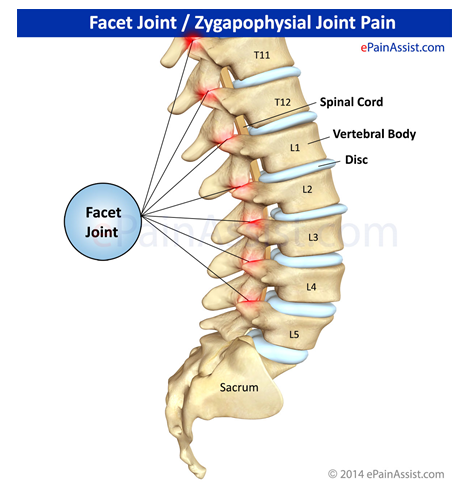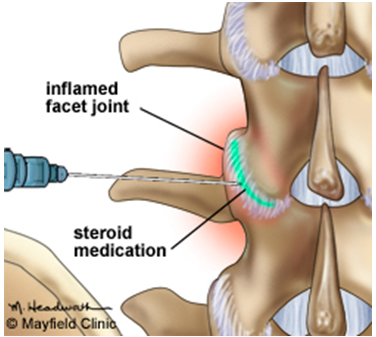By: Dr. Rami Rustum – Dec. 2016
 There are numerous facet joints in the body; they are the small joints behind and between each of the vertebrae in the spine, allowing you to bend forward and backward but controlling twisting motion of the spine. Everyday wear and tear, arthritis, or a single injury can damage these joints, damaging the joint’s cartilage and creating chronic and sometimes debilitating low back pain.
There are numerous facet joints in the body; they are the small joints behind and between each of the vertebrae in the spine, allowing you to bend forward and backward but controlling twisting motion of the spine. Everyday wear and tear, arthritis, or a single injury can damage these joints, damaging the joint’s cartilage and creating chronic and sometimes debilitating low back pain.
Chronic facet joint pain is defined as pain originating in the facet joints which has lasted for three months or longer. When facet joint pain becomes chronic, it may also be known as facet joint syndrome. The facet joint pain may occur on its own, or in combination with other sources of low back pain. If you believe your low back pain is caused by the facet joints, learning about the causes, symptoms, diagnosis and treatment options can help you find the relief you need.
Causes:
Facet joint syndrome can be caused by a combination of aging, pressure overload of your facet joints, and injury.
Pressure overload on your facet joints is probably caused by degeneration of the intervertebral discs in your spine. As the discs degenerate, they wear down and begin to collapse. This narrows the space between each vertebra.
This narrowing of the space between each vertebra affects the way your facet joints line up. When this occurs, it places too much pressure on the articular cartilage surface of the facet joint. The excessive pressure leads to damage of the articular surface and eventually the cartilage begins to wear away.
 When facet joint arthritis gets bad enough, the cartilage and fluid that lubricate the facet joints are eventually destroyed as well, leaving bone rubbing on bone. Bone spurs begin to form around the facet joints. When bone spurs develop, they can take up space in the foramen (the opening between vertebrae where nerve roots exit the spine) and press into nerve roots. As the bone spurs begin to grow larger, they can eventually extend into the spinal canal itself. This leads to narrowing of your spinal canal, called spinal stenosis.
When facet joint arthritis gets bad enough, the cartilage and fluid that lubricate the facet joints are eventually destroyed as well, leaving bone rubbing on bone. Bone spurs begin to form around the facet joints. When bone spurs develop, they can take up space in the foramen (the opening between vertebrae where nerve roots exit the spine) and press into nerve roots. As the bone spurs begin to grow larger, they can eventually extend into the spinal canal itself. This leads to narrowing of your spinal canal, called spinal stenosis.
Symptoms:
Patients with facet joint syndrome have difficulty twisting and bending their spine. If you have facet joint syndrome in your cervical spine (your neck), you may have to turn your entire body to look left or right. Facet joint syndrome in your lumbar spine (low back) may make it difficult for you to straighten your back or get up out of a chair.
Pain, numbness, and muscle weakness associated with facet joint syndrome will affect different parts of your body depending on which of your nerves are being affected. If the nerves affected are in your cervical spine, you may have symptoms in your neck, shoulders, arms and hands. If the nerves are in your lumbar spine you may have symptoms in your buttocks, legs, and feet.
Diagnosis:
The diagnosis of facet joint syndrome usually begins with a complete history and physical exam. Your doctor may order other diagnostic tests as well. X-rays may be recommended to determine whether there are abnormalities in your spine. A CT scan can sometimes show more detail about your facet joint surfaces. If the X-rays suggest something may be affecting your facet joints, your doctor may recommend a CT scan to get a better look. A bone scan can be useful in determining whether your facet joints are inflamed. An inflamed facet joint usually shows up as a hot spot on a bone scan.
Treatment Options:
Conservative Treatment
Once a diagnosis of facet joint syndrome has been confirmed, your doctor will likely recommend course of NSAID’s ( Ibuprofen, Naproxen..) and muscle relaxant with some rest. Physical therapy is usually added for maximum benefit. A well-rounded rehabilitation program assists in calming pain and inflammation, improving your mobility and strength, and helping you do your daily activities with greater ease and ability. Physical therapy may also include the use of ice to decrease blood flow to the affected area and reduce swelling. Ultrasound and electrostimulation may also be used to treat muscle spasms. Massage and muscle stretching may also be helpful. When you’re feeling better, exercises will help you regain joint mobility, flexibility, and strength.
Spinal Injection
An injection into your facet joint using cortisone can be helpful for calming pain and inflammation. The injection usually gives temporary or extended relief for several weeks or months.
Surgical Treatment
Surgery may become an option if all conservative methods of treatment fail. Surgery on the facet joint usually consists of a fusion of the joint (also called an “arthrodesis”). To join the two vertebrae together, the doctor will usually insert several metal screws across the joint. Bone graft may also be placed around the joint to help fuse it. The bone graft is usually removed from your pelvic bone right beside the SI joint.
Dr. Rami Rustum of Merrimack Pain Management Associates is located at 280 Merrimack St, Lawrence, MA 01843 | Phone: (978) 685-2455
